Expert Guide to Parrot Breeder Cages Maintenance
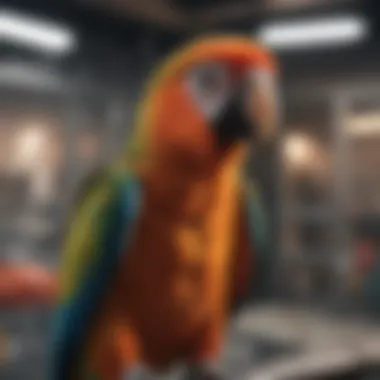
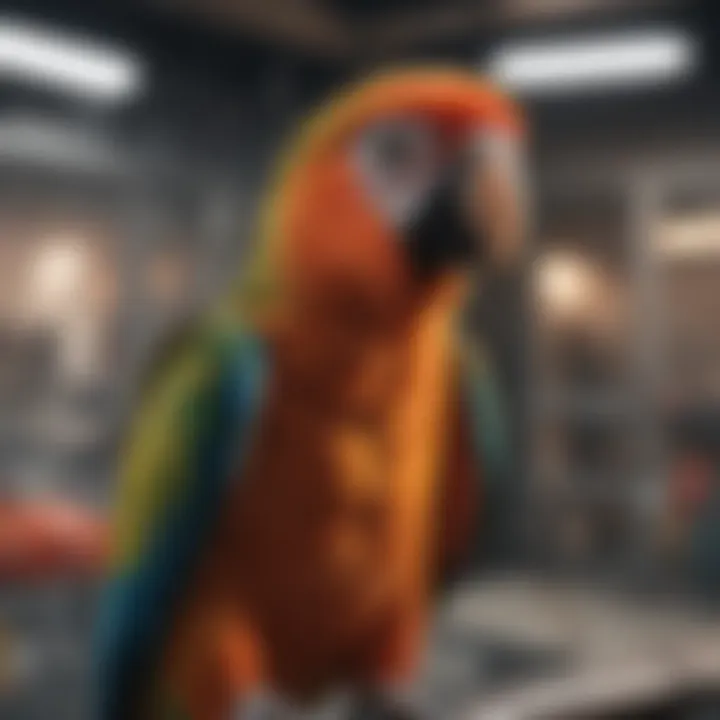
Intro
The selection and maintenance of parrot breeder cages require careful consideration. These cages not only serve as homes for parrots but also play a critical role in their health and behavior. An inadequately designed cage can contribute to stress and inhibit natural behavior, while a well-chosen cage can promote well-being and successful breeding. Understanding the nuances of cage selection can set the groundwork for a thriving avian environment.
Selecting a proper cage involves various factors, such as the species of parrots being bred, their behavioral needs, and the dimensions of the cage. Additionally, regular maintenance is paramount. Cleanliness, proper setup, and hygiene practices create a safe and healthy space where parrots can thrive. In this article, we will delve into essential care tips, behavioral insights, nutrition guides, wellness and health considerations, and activities for enrichment—all crucial for maintaining a healthy breeding environment for these intelligent birds.
Prelims to Parrot Breeder Cages
Parrot breeder cages play a crucial role in the overall breeding process. Understanding the nuances of these cages can significantly affect the health and well-being of the parrots housed within them. The right selection of a breeding cage is essential for facilitating successful reproduction and ensuring the comfort of both the breeding pairs and their offspring. This section addresses why appropriate housing is important and examines the breeding environments necessary for optimal avian welfare.
Importance of Appropriate Housing
The type of cage chosen for breeding parrots has far-reaching implications. First, it is a matter of space; parrot species vary in size and behavior, and their housing must reflect these differences. Cages that are too small can lead to stress and aggression, not just among the breeding pairs but also among the chicks. Inadequate space does not allow parrots to display natural behaviors, which can hinder their development.
Moreover, appropriate housing contributes to the physical health of the birds. A well-designed cage allows for proper ventilation and light, crucial factors that influence a parrot's vitality. Damp or poorly lit environments can encourage the growth of harmful bacteria and fungi, leading to health issues. Furthermore, providing accessible perches and nesting areas promotes comfort and fosters a secure environment for both the parents and the eggs.
In essence, the choice of a breeding cage is more than just aesthetics. It directly relates to the success of breeding efforts and the overall welfare of the parrots. Making an informed decision regarding cage selection allows breeders to create an environment conducive for breeding, nurturing, and ultimately producing healthy chicks.
Overview of Breeding Environments
Understanding breeding environments is essential for successful parrot breeding. Several factors influence the ideal conditions for breeding, including temperature, humidity, and light availability. Parrots thrive in environments that mimic their natural habitats as closely as possible. Optimal conditions must be established to support the reproductive cycle of the birds.
An effective breeding environment needs to ensure stable temperature and humidity levels. Swift temperature fluctuations can be detrimental to the health of parrots, particularly during the critical breeding period. Parrots usually prefer a warm environment, and maintaining a temperature range suitable for their species encourages healthy reproduction.
In addition, managing light exposure is critical. Parrots exhibit certain breeding behaviors in response to changes in daylight hours. Proper lighting will stimulate the breeding instincts in these birds. Some breeders use timers to simulate natural daylight conditions, helping to optimize breeding cycles.
Lastly, keeping the breeding area quiet and free from disturbances is vital. Stress from loud noises or frequent disruptions can seriously affect breeding success. Keeping distractions to a minimum fosters a safe space where parrots can thrive and effectively raise their young.
"A conducive breeding environment can mean the difference between success and failure in breeding parrots."
Types of Parrot Breeder Cages
Understanding the various types of parrot breeder cages is crucial for optimizing both breeding practices and the well-being of the birds. Different types of cages cater to specific needs based on the species, the breeding environment, and the expected outcomes from breeding efforts. This knowledge assists both novice and experienced breeders in making informed decisions that contribute to the health, safety, and comfort of their parrots.
Single Breeder Cages
Single breeder cages are designed to house a single pair of parrots. These cages are often spacious enough to offer enough room for the birds to move around freely while nesting. One significant advantage of single breeder cages is that they allow for focused observation and care. Breeders can easily monitor the behavior, health, and breeding activity of the pair without distraction from other birds.
In terms of design, single breeder cages typically include designated areas for nesting, feeding, and perching. A sufficient height is essential, along with a width that allows for enough activity. It is essential to select materials that are durable and easy to clean, ensuring long-term use and hygiene.
Multi-Compartment Cages
Multi-compartment cages are an excellent choice for breeders managing several pairs of birds at once. These cages often feature separate compartments for each pair, which helps reduce competition and stress among the birds. Each compartment can be customized with nesting boxes, perches, and eating areas to meet the specific needs of different parrot species.
The advantage of these cages lies in their ability to provide a controlled environment for various pairs simultaneously. Breeders can effectively manage breeding cycles and health care routines within a confined area. Additionally, multi-compartment cages facilitate easier cleaning and maintenance as each section can be approached individually. However, these cages require careful planning regarding ventilation and access to ensure that each pair's comfort is not compromised.
Outdoor vs Indoor Cages
When considering parrot breeder cages, deciding between outdoor and indoor options is critical. Indoor cages typically offer controlled environmental conditions, protecting birds from extreme weather, predators, and direct sunlight. They are often easier to maintain and keep clean compared to outdoor cages.
On the other hand, outdoor cages provide exposure to fresh air and natural sunlight, which are beneficial for the birds' well-being. However, outdoor cages must be constructed with durability in mind, utilizing materials that can withstand weather variations and potential wildlife threats. Proper ventilation and shade options are also necessary to protect the birds from heat.
Ultimately, the choice between outdoor and indoor cages will depend on your local climate, the species of parrots you are breeding, and your specific breeding goals.
"Choosing the right type of cage is fundamental for the health and safe breeding of parrots, influencing overall outcomes and the quality of life for these birds."
By understanding the inherent benefits and challenges associated with each type of breeder cage, bird owners can enhance their breeding success while prioritizing their birds' needs.
Key Features of Breeder Cages
Understanding the key features of parrot breeder cages is crucial for ensuring the health and well-being of breeding birds. Each feature contributes to a safe and comfortable environment, promoting both successful breeding and the overall welfare of the parrots. Important aspects to consider include material, dimensions, and the technicality of spacing and configuration of bars. Selection based on these features directly impacts not only the livability of the cage itself but also the behavior and health of the parrots housed within it.
Material Considerations
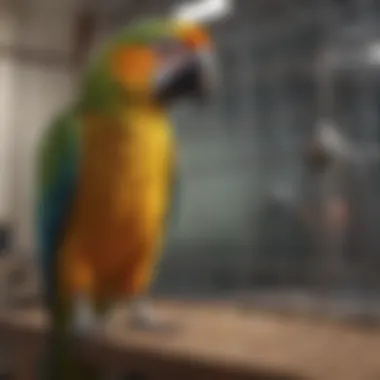
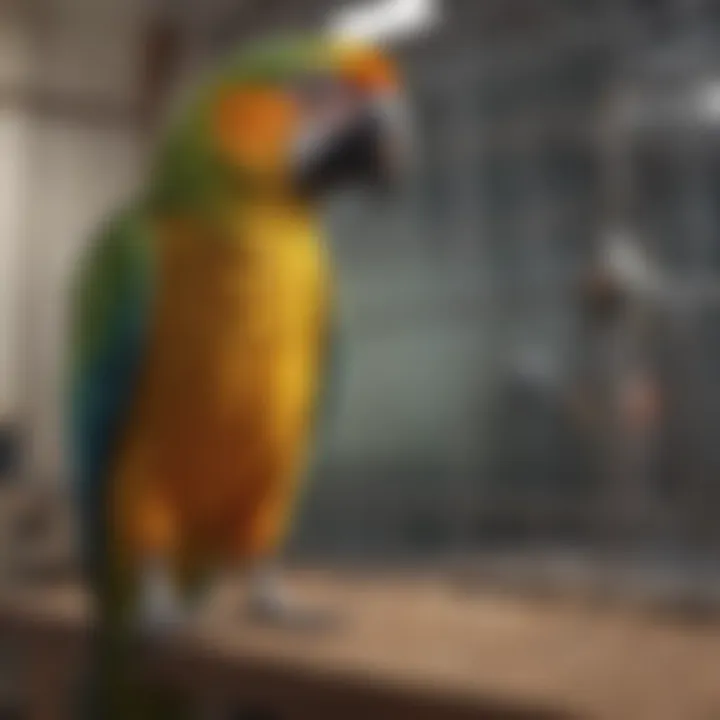
Stainless Steel
Stainless steel is a highly recommended material for parrot cages due to its durability. It resists corrosion and is easy to clean, which is vital in a breeding environment. Another important characteristic is its strength; stainless steel does not easily bend or break, ensuring long-term safety and reducing the risk of injury to the birds. Although it is often a more expensive option, the longevity it provides makes it a beneficial choice for breeders serious about their avian pets.
Powder-Coated Metals
Powder-coated metals are also popular for cage construction. This material is coated with a layer that protects against rust and corrosion. One of the standout attributes of powder coating is the wide variety of colors and finishes available, allowing for some customization of the cage's appearance. However, it can chip if not handled carefully. Despite this disadvantage, the aesthetic appeal and protective qualities make powder-coated metals a common choice among many breeders.
Plastic Components
Plastic components often complement metal cages, used mostly for feeders and perches. They are lightweight and come in various shapes and sizes. A key advantage is their ease of installation and cleaning. Plastic pieces are generally affordable, which makes them accessible for many bird owners. However, they can be less durable than metal options. In the long run, their susceptibility to wear and tear may be a downside, necessitating replacements more often.
Cage Dimensions
Height Requirements
Cage height is essential in promoting natural behaviors in parrots. Birds need space to fly and move around comfortably. A higher cage allows for vertical activity, which is crucial for larger species. It's crucial to note that height regulations will vary by species and age. Generally, higher cages encourage more vigorous behavior and contribute to the physical health of the birds.
Width and Depth Standards
Alongside height, the width and depth of a cage are equally significant. Adequate width prevents overcrowding and allows for the social interactions that many parrots enjoy. When choosing a cage, it is advisable to select the largest size suitable for the specific type of parrot being housed. This ensures the birds have enough room to comfortalbly move about. Inadequate space can lead to stress, affecting the breeding behavior negatively.
Bar Spacing and Configuration
Ideal Spacing for Safety
The spacing between bars is a critical feature for safety purposes. The ideal spacing must prevent the birds from escaping or getting their heads stuck, which can result in injury. A well-configured cage considers the species’ size; larger spaces may work for larger parrots but can be hazardous for smaller types. Ensuring adherence to appropriate spacing standards will safeguard the welfare of the birds.
Bar Thickness and Strength
The thickness of the bars is also vital, as it directly influences the cage’s overall strength. Thicker bars can withstand more force, which is necessary for active birds that may be prone to attempting to escape. Choosing materials that are specified for the particular species ensures longevity and usability of the cage. A strong configuration ultimately translates to improved safety in the long run.
Design Considerations for Breeder Cages
When selecting a suitable cage for parrot breeding, design considerations play a crucial role. The right design not only ensures the comfort and safety of the birds but also influences their health and breeding success. Key elements to focus on include accessibility, ventilation, and lighting, which each contribute to creating an optimal environment for breeding parrots.
Accessibility for Maintenance
Accessibility is a foundational element in the design of breeder cages. Easy access to the inside of the cage is necessary for routine cleaning and maintenance. This includes the ability to reach feeders, water dishes, and nesting boxes without hassle. Properly positioned doors and removable trays can significantly facilitate quick cleaning processes.
A well-designed cage should allow breeders to monitor the health of the birds easily. Being able to observe behaviors and interactions, without causing stress to the birds, is vital. In addition, consider the height and width of the cage. It should be feasible to reach inside without discomfort. Factors like the distance from the floor and the overall size matter.
Ventilation Requirements
Ventilation is another design consideration that should not be overlooked. Adequate air circulation within the cage helps prevent the buildup of harmful gases and stale air, which can lead to respiratory issues for the parrots. Proper airflow also contributes to temperature regulation, ensuring that the interior does not become excessively warm or humid.
Design features such as mesh panels or strategically placed vents can enhance airflow efficiency. The choice of materials can also impact ventilation. For instance, cages made primarily of stainless steel allow for better air passage compared to those made of less breathable materials. In addition, an owner should consider the location of the cage. It must be placed in an area with natural airflow to further promote healthy conditions.
Lighting and Temperature Regulation
Lighting within the cage has substantial effects on the well-being and behavior of parrots. It is important to ensure that the design supports natural lighting, as parrots benefit from exposure to sunlight for their health and well-being. Where natural light is limited, breeders may need to invest in appropriate artificial lighting solutions that simulate natural day and night cycles.
Temperature is equally important; cages should be designed to protect birds from extreme temperatures. In colder climates, additional insulation may be needed, while in hotter regions, options for shade or cooling mechanisms should be considered. Proper regulation ensures that the birds remain healthy and stress-free during their breeding period.
"A cage that meets the environmental and behavioral needs of parrots can significantly enhance the breeding experience."
In summary, considering design elements such as accessibility, ventilation, and lighting is essential when selecting parrot breeder cages. Each factor contributes to a stable and healthy environment conducive to breeding and overall well-being of the birds.
Choosing the Right Cage for Specific Parrot Species
Selecting a suitable cage for parrot species is critical. Each species has unique behavioral traits, physical needs, and social preferences that must be considered. Proper cage selection supports their health and well-being, thus enhancing their quality of life in captivity. A cage designed for a specific species will allow for natural behaviors like moving, climbing, and playing. Through an understanding of each species' requirements, breeders can create an environment that promotes comfort and reduces stress.
Cockatoos
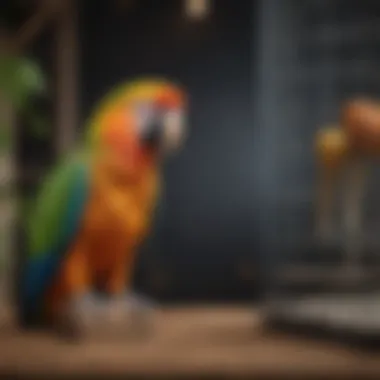
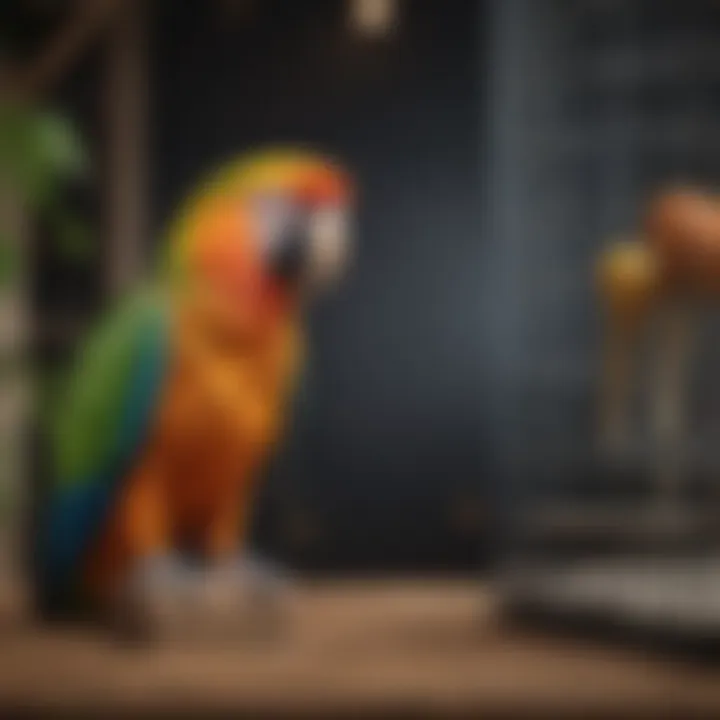
Cockatoos are known for their social nature and intelligent behavior. Therefore, the cage for cockatoos should be spacious enough to allow them to move around comfortably. A minimum cage size for a single cockatoo is about 24 inches wide, 36 inches high, and 36 inches deep. Cockatoos love to climb and play, so including various perches and toys inside the cage can keep them engaged.
Additionally, bar spacing should be no more than ¾ inch to prevent escape or injury. It's also beneficial to have a cage with a removable tray at the bottom for easy cleaning. Since cockatoos are prone to boredom, they need a stimulating environment that will keep them active and joyful.
Macaws
Macaws require extensive space due to their large size and high energy levels. A suitable cage should measure at least 36 inches wide, 48 inches high, and 36 inches deep for a single macaw. Strong, durable materials such as stainless steel are recommended to withstand their powerful beaks. The bar spacing should also not exceed 1 inch to ensure their safety.
Macaws thrive on interaction and require ample toys for mental stimulation. Moreover, when selecting a cage for macaws, it’s crucial to provide access to natural light. Ideally, the cage should be located in a well-lit area but away from direct sunlight to avoid overheating.
Amazon Parrots
Amazon parrots are known for their playful and competitive nature. For these birds, a cage should be generous in size, ideally 30 inches wide, 36 inches high, and 30 inches deep. They love having various perches at different heights. Tough wooden or natural perches can offer good support and satisfy their need to chew.
Bar spacing should be around ¾ inch to facilitate safety and prevent escapes. Providing a variety of toys is essential to keeping Amazons occupied. Additionally, an area for bathing within or near the cage can aid in hygiene and enhance their living experience.
Smaller Parrot Species
For smaller parrot species like budgerigars or lovebirds, cages need to be smaller but still provide enough room for play and movement. A standard size would be around 18 to 24 inches wide, 24 inches high, and 18 inches deep. While smaller than those for larger species, these cages should still feature multiple perches and hanging toys to stimulate activity.
Bar spacing can be around ½ inch to accommodate their small size securely. Keep in mind that these smaller parrots also enjoy social interaction, so ensuring that the cage allows for bonding time with other birds is important.
Choosing the correct cage for different parrot species impacts their overall health and happiness. Tailored environments promote better behaviors and lesser stress levels, ultimately leading to a successful breeding experience.
In summary, understanding specific needs of each parrot species guides the selection of an appropriate cage. In doing so, avian enthusiasts can foster a more enriching and joyful avicultural environment.
Maintenance of Parrot Breeder Cages
Maintaining parrot breeder cages is an essential aspect of aviculture that directly impacts the health and well-being of the birds. Clean and well-maintained cages reduce the risk of illness, promote mental stimulation, and create a safe environment. Parrots are naturally curious and active creatures; thus, the state of their cages can significantly affect their behavior and breeding success. Regular upkeep ensures that the spaces where they live are hygienic and conducive to their needs.
Regular Cleaning Routines
Establishing a systematic cleaning routine is vital for proper maintenance of parrot breeder cages. Daily tasks should include removing uneaten food and waste, as these can attract pests and harbor bacteria. It is advisable to perform a thorough cleaning at least once a week. This process should involve:
- Wiping down surfaces with mild, bird-safe cleaners to remove debris and prevent buildup.
- Changing bedding materials to ensure a clean and comfortable floor. Paper or sandalwood shavings can be good choices.
- Checking and cleaning food and water containers regularly, ensuring they are free from mold and contamination.
Creating a checklist can help owners stay organized and meet all cleaning requirements effectively. Consistency in these practices leads to a healthier living space for the parrots.
Sanitizing Procedures
Sanitizing cages goes beyond surface cleaning. To protect the birds from pathogens, a more comprehensive approach is necessary. It is crucial to use appropriate disinfectants that are safe for birds. Procedures to follow include:
- Remove all accessories from the cage, including toys, perches, and dishes.
- Apply a suitable disinfectant on all surfaces and allow it to sit for the recommended contact time.
- Rinse surfaces thoroughly to eliminate any residue.
- Air out the cage to ensure proper ventilation before returning accessories.
Maintaining a sanitization schedule can significantly reduce the risk of disease transmission. Recommended frequency can vary depending on the number of birds and their health status. In cases of illness, heightened sanitizing measures are essential.
Identifying Wear and Tear
Regular inspections for wear and tear in cages are crucial for the safety of parrots. Over time, materials can degrade, presenting hazards. Signs to look for include:
- Rust on metal cages, which can lead to exposure to toxic elements.
- Frayed or broken perches that can cause injury.
- Weakening joints or connectors in multi-compartment setups.
If any damage is spotted, promptly replacing parts is essential. Not only does this maintain the cage's structural integrity, but it also safeguards the well-being of the birds. Maintaining a log for inspections and repairs helps ensure that no aspect is overlooked.
Regular maintenance of parrot breeder cages is not just about cleanliness; it is an investment in the long-term health and happiness of the birds.
Behavioral Needs and Enrichment
The significance of understanding the behavioral needs and enrichment of parrots cannot be overstated. Parrots are intelligent and social creatures, and their well-being depends heavily on the adequacy of their environment. Providing the right type of enrichment and facilitating social interaction plays a crucial role in their overall health, happiness, and breeding success. Addressing these needs is fundamental for any aviculture plan, ensuring that parrots can express natural behaviors, which is essential for their mental and physical well-being.
Social Interaction Requirements
Parrots are inherently social animals. In the wild, they live in flocks and engage in various social behaviors, which contribute to their emotional stability. When selecting a cage for breeding purposes, it is crucial to consider the social interaction requirements of these birds.
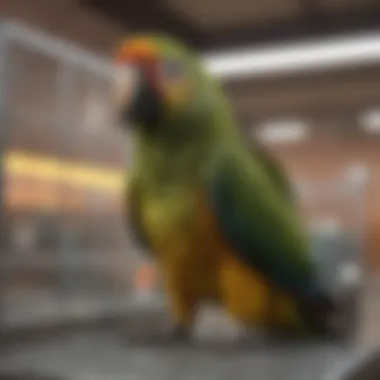
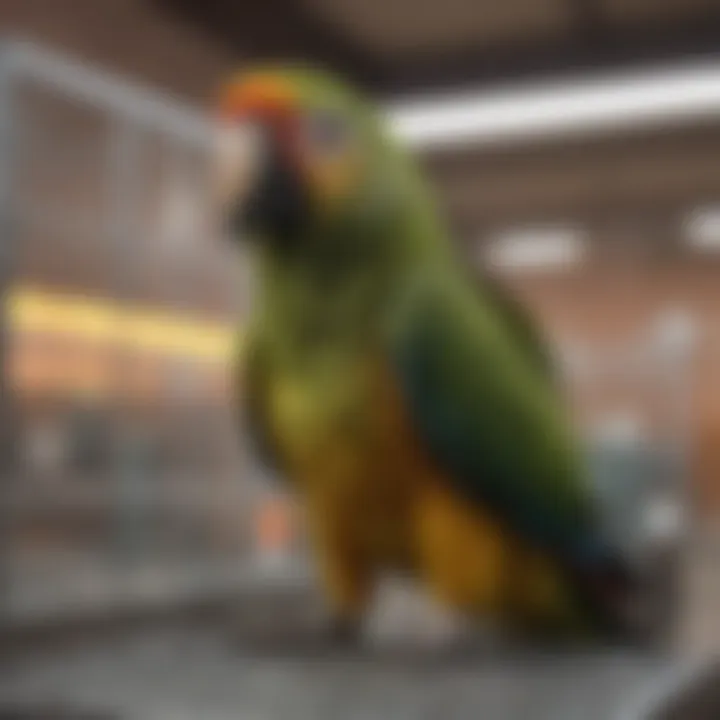
Including two or more birds in a breeding setup can present challenges but also allows for natural interaction. In cases where keeping multiple parrots is not feasible, it is vital to interact with them daily. This interaction can include talking, playing, and training, as these activities mimic the flock interactions they experience in nature. Breeding pairs should also be monitored during their reproductive phase to ensure compatibility and reduce stress.
The emphases on social interaction highlight:
- Reduced Stress: Continuous contact with others can alleviate stress, making breeding more successful.
- Behavioral Enrichment: Birds that engage socially exhibit less destructive behavior and can adapt better to new environments.
- Health Benefits: A happy parrot often shows improved health, displaying vitality that can enhance breeding performance.
Providing Enrichment Tools
Enrichment tools are vital for stimulating mental activity and diminishing boredom in parrots. Obstruction of natural behaviors can lead to issues such as feather plucking or aggression. Thus, the introduction of various items is essential for their cognitive engagement.
When selecting enrichment tools, consider incorporating the following:
- Toys: Durable toys made from safe materials can promote chewing and manipulation, crucial for keeping their beaks healthy.
- Foraging Opportunities: Create challenges that allow parrots to search for food. This can replicate their natural foraging behavior, enhancing their psychological health.
- Natural Branches: Providing natural perches of various sizes and textures not only satisfies their need to explore but also maintains good foot health.
- Interactive Activities: Reflect on training sessions that incorporate puzzles or games. This increases their problem-solving skills and fosters a stronger bond between the parrot and the owner.
Enrichment tools must be safe, non-toxic and regularly rotated to maintain interest. By diversifying these activities, you can offer a continuously stimulating environment which is critical for parrot welfare.
Selecting the right cage and ensuring engagement through these tools not only ensures the happiness of parrots but also optimizes breeding conditions. In the end, a careful consideration of behavioral needs and appropriate enrichment encourages a thriving environment for both breeders and their feathered companions.
Implications for Aviculture and Breeding Practices
Understanding the implications for aviculture as well as breeding practices is crucial for anyone involved in this field. The welfare of parrots in breeding environments ties directly into their behavior, health, and overall quality of life. The choice of breeding practices can determine the success of aviculture efforts and significantly affect the parrot's emotional and physical well-being.
Maintaining ethical breeding methods is essential. It fosters a reputation for accountability among breeders and reflects a commitment to protecting these intelligent birds. Ethical aviculture starts with knowledge about specific parrot species and their natural habitats. This awareness promotes informed decision-making regarding selection, care, and breeding.
The environment parrots are raised in is also vital. Cages designed with their well-being in mind enhance their living conditions significantly. Proper cage selection can improve birds' mood, reduce stress, and help prevent various behavioral issues. When cages are well-maintained and suited for the specific species, the chances of successful breeding increase, thus contributing to healthier offspring and promoting sustainable practices within aviculture.
Notably, the impact of breeding on wild populations cannot be neglected. Responsible breeders work to minimize their ecological footprints while also prioritizing genetic diversity in their aviaries. Breeding practices can influence not only individual birds but whole populations, making these considerations essential for the sustainability of aviculture.
Ethical breeding practices benefit both the birds and the breeding community over a longer period.
Ethics of Breeding Practices
The ethics of breeding practices encompasses how breeders handle their responsibilities toward both their birds and the broader environment. Both practices should be firmly rooted within the principles of animal welfare.
A transparent approach is essential. Breeders should be willing to share information regarding their methods and the challenges they face. This openness can help educate prospective bird owners or breeders about what to expect when engaging in aviculture. Additionally, breeders must continually evaluate their practices to ensure they align with best welfare standards. This evaluation might involve seeking regular feedback from peers and avian veterinarians to refine methods further.
Moreover, ethical breeding entails a commitment to avoid practices linked to detrimental health outcomes. This includes avoiding inbreeding, which can lead to genetic disorders and diseases in parrots.
Finally, breeders should ensure their practices are sustainable. This includes considering the societal implications of breeding more parrots when many species are already under threat in the wild. Balancing the responsibility toward nurturing avicultural practices while respecting the needs of wild populations is critical.
Potential Challenges in Breeding
Breeding parrots is not without its challenges. There are various factors that can complicate the practice and potentially threaten both the welfare of the birds and the objectives of the breeders.
One of the most significant challenges is understanding the specific needs of different parrot species. Not all parrots breed in the same way, and mismanagement can lead to breeding failures. For example, some species require specific environmental conditions or diets to breed successfully.
Another challenge is dealing with behavioral issues that may arise during the breeding process. Parrots are social creatures, and improper handling of their social dynamics can lead to stress or aggression among birds. Thus, experts recommend experts to closely observe interactions and adjust practices accordingly.
Additionally, the availability of resources can pose a challenge. Breeders need access to a wide array of enrichment tools tailored for their birds. If these resources are limited, maintaining the right behaviors and promoting a healthy dynamic can be difficult.
Lastly, economic factors cannot be ignored. Breeding requires ongoing investments in quality cages, food, and healthcare. Financial constraints can create pressure on breeders, leading to compromised standards and potentially harming the birds' quality of life.
In summary, the implications of breeding practices for aviculture entail a web of ethical concerns and practical challenges that require careful navigation. By prioritizing ethical considerations and recognizing potential hurdles, those engaged in parrot breeding can work toward more sustainable and responsible practices.
Ending
In the realm of aviculture, the significance of selecting and maintaining parrot breeder cages cannot be overstated. The appropriate cage serves as a foundational element in breeding practices, influencing the overall health and well-being of each parrot. Throughout this article, we have examined several crucial factors linked to the selection process.
Recap of Key Insights
- Cage Type: Choosing the right type of cage—whether single or multi-compartment—is essential to accommodate different parrot species and their respective behavioral and social needs.
- Material and Design: The materials used in cage construction, such as stainless steel or powder-coated metal, directly affect the longevity and safety of the environment.
- Maintenance Practices: Regular cleaning and sanitizing routines must be established to prevent health issues. Additionally, paying attention to signs of wear and tear like rust or scratches is necessary to ensure the cage remains safe.
- Behavioral Needs: Understanding the social requirements and enrichment tools necessary for parrots greatly enhances their well-being and reproductive success.
Through these insights, it becomes clear that comprehensive knowledge in breeding practices leads not only to better outcomes and healthier birds but also fosters a more responsible approach to aviculture.
Future Considerations for Breeders
Looking ahead, several considerations should guide parrot breeders in their practices:
- Research and Education: Continuous learning about different parrot species and their habitats can assist in better cage selection and maintenance strategies.
- Sustainability: Investing in durable materials and eco-friendly practices will contribute positively to the environment while ensuring a safe space for parrots.
- Technology Integration: Utilizing modern technology such as automated cleaning systems or climate control can enhance breeding environments and ensure that specific needs are truly met.
- Community Engagement: Participating in forums or local aviculture groups, such as those found on Reddit, will provide valuable insights and support from fellow breeders.
As the field of aviculture continues to evolve, adapting to new information and practices will be essential for the future of responsible breeding.















